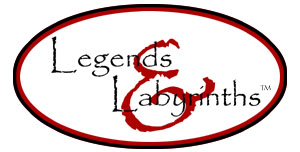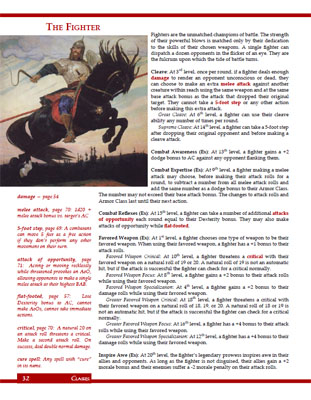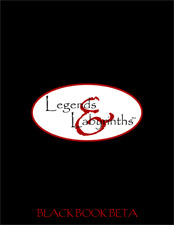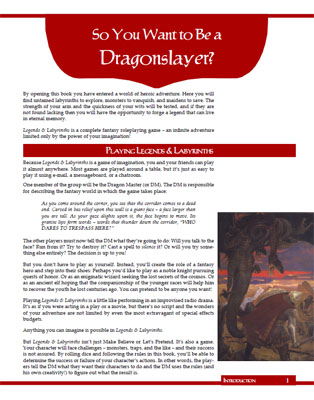This article has been updated and expanded. Read the current version here.
I think stat blocks can tell you a lot about a roleplaying game. What type of information do you need to juggle? What does the game consider important in distinguishing one character from another? How complicated will a game be to prep and run?
Holding that thought in mind, let’s take a brief tour of the stat block.
THE 1970’s
The first published adventure module was “Temple of the Frog” in Supplement II (1976). It didn’t contain stat blocks, instead describing everything narratively. For example: “…the room which contains five skeletons of 2 hit dice that have armor class 7 and move 6″ per turn.”
Next came Palace of the Vampire Queen (1976), in which the entire adventure key was presented in semi-tabular fashion. But basically here you could interpret a “stat block” of sorts which included the creature encountered and their hit points. For example: “2 vampire guards – 23, 26”
Unfortunately, I have never seen a copy of the original Lost Caverns of Tsojconth (1976) from the Metro Detroit Gamers or Gen Con IX Dungeons from Judges Guild. But I do own a copy of the revised City State of the Invincible Overlord, which used tables for many NPC stats but also included what may be the first true stat blocks with entries like these:
Two Mercenaries: FTR, N, LVL: 3, HTK: 16-20, AC: 6
Bartender Koris Brightips: FEM, FTR, CG, LVL: 2, HTK: 4, AC: 9, Dagger, sings.
We see similar stat blocks from Judges Guild throughout ’77 in Tegel Manor, First Fantasy Campaign (Arneson), and Modron.
In ’78, TSR publishes the G series, D series, S1, and B1. In G1, monsters were still being largely described narratively as they were in “Temple of the Frog”, although hit point totals were now being given in parentheses: “Here 12 young giants (H.P.: 26, 24, 3 x 21, 18 x 17 [sic], 2 x 16, 14, 13) are rollicking, and beefy smacks, shouts, laughter, etc. are easily heard. All these creatures have weapons and will fight as ogres.” and “14 dire wolves run free here (H.P.: 25, 23, 22, 2 x 10, 19, 3 x 18, 2 x 17, 15, 13, 12).”
By the time D1 rolls around, more information is being dropped into the parentheses but things are still pretty narrative. For example: “This 6th level cleric (H.P. 30; +3 chain mail, +3 buckler, +1 for dexterity of 15, for an overall AC of -3) carries a +1 mace on her belt, for her major weapon is a short-handed staff sling. This weapon hurls missiles up to 9″ distance (providing the ceiling is at least 30′ high), minimum range 3″. Probability of a hit is normal out to 6″, -2 thereafter.”
By ’79, Judges Guild has firmed their presentation of NPC statistics into definite stat blocks. For example, here’s the text from key V-5 in Dark Tower:
Avvakris: 10th level cleric of Set, Align: CE, chainmail, AC: 5, HP: 50, S: 14, I: 14, W: 15, D: 14, C: 11, CH: 15, weapon: mace, spells: bless (reverse), create water (reverse), detect good, detect magic, hold person (x3), silence 15′ radius, animate dead, dispel magic, speak with dead, cause serious wounds (x2), divination, flame strike (x2.)
Seth the Huge: 6th level fighter, align: CE, chainmail and shield, +3 dexterity bonus, AC: 1, HP: 34, weapon: longsword, S: 16, I: 8, W: 5, D: 17, C: 11, CH: 12. Large and cruel looking.
Wormgear Bonegnawer: 6th level fighter, align: CE, chainmail and shield, +1 dexterity bonus, AC: 3, HP: 48, weapon: longsword, S: 16, I: 11, W: 14, D: 15, CH: 11.
TSR, too, is firming things up. In T1 The Village of Hommlet, stats are still being dropped into the middle of paragraphs, but they’re being completely contained in parentheses which are gaining a standardized form. A couple examples:
Canon Terjon (6th level cleric — S 11, I 10, W 16, D 12, C 16, Ch 8 — chain mail, shield +1, mace; 41 hit points; invisibility and mammal control rings; typical spells noted hereafter)
Jaroo Ashstaff (7th level druid — S 11, I 11, W 18, D 9, C 15, Ch 15 — HP: 44, padded armor, cloak of protection +2, staff of the snake, +1 scimitar, ring of invisibility; spells given below)
black bear (AC 7; HD 3+3, HP: 25; 3 attacks for 1-3/1-3/1-6 plus hug for 2-8 on a paw hit of 18)
two dogs (AC 7; HD 1+1, HP: 5, 4, 1 attack for 1-4 hit points of damage).
THE LONG, SLOW EXPANSION
By 1980, stat blocks were assuming standardized forms and TSR was creating editorial standards which applied to all their products.
AD&D stat blocks from T1-4:
Black Bear: AC 7; HD 3 +3; hp 25; #AT 3; D 1-3/1-3/1-6; SA Hug (if paw hit 18+); Dmg 2-8; XP 185
Jaroo Ashstaff: AC 6 (padded armor); Level 7 Druid; hp 44; #AT 1; D by weapon or spell; XP 1427; cloak of protection +2, ring of invisibility, staff of the serpent (python), scimitar +1
Standard druid abilities: identify plant type, animal type, pure water; pass without trace; immune to woodland charm; shapechange 3 times per day; +2 bonus to saving throws vs. lightning; q.v. PH page 21.
Spells normally memorized:
First level: detect magic, entangle, faerie fire, invisibility to animals, pass without trace, speak with animals
Second level: barkskin, charm person or mammal, cure light wounds, heat metal, trip, warp wood
Third level: cure disease, neutralize poison, summon insects, tree
Fourth level: cure serious wound, plant door
Spell lists are obviously, by their very nature, lengthy. But you can see how clean and elegant this standardized “stat-line” format is for the stat block. Albeit nearly incomprehensible when you first look at it, it doesn’t take much familiarity with the rules before this stat block becomes very easy to use by virtue of compactly presenting every piece of necessary information and putting it right at your fingertips.
BECMI stat blocks were largely identical:
Goblins. (2d4) AC 6; HD 1-1; hp 3 each; MV 90′ (30′); #AT 1; D 1d6; Save NM; ML 7; AL C; XP 5 each. Each goblin carries a spear and 2-12 ep.
Champion (7th level Fighter): AC 6; F7; hp 42; MV 120′ (40′); #AT 1; D 1d4 (+2 for magic weapon); Save F7; ML 9; AL L; XP 450.
And these stat blocks were largely unaltered when 2nd Edition rolled around. Here’s a sample from a late-2nd Edition module:
Behir: AC 4; MV 15; HD 12; hp 70; THAC0 9; #AT 2 or 7; Dmg 2d4/1d4+1 (bite and constriction) or 2d4/1d6 (bite/6 claws); SA once every 10 rounds can breathe bolt of lightning up to 20 feet long that inflicts 24 points of damage (save for half), swallow whole on an attack roll of 20 (victim loses % of starting hp until death on the 6th round, can cut himself out by attacking AC 7, but each round the victim spends inside the behir he faces a cumulative -1 damage penalty); SD immune to electricity and poison; SZ G (40′ long), ML Champion (15); Int Low (7); AL NE; XP 7,000
But here we can start making two additional observations. First, as the rules for a creature become more complicated, the short simplicity of the stat block begins to decay into a mass of incomprehensible text. Second, as rules for creatures become less dependent on a chart look-up keyed to Hit Dice, more information needs to be coded into the stat block (like THAC0), contributing to the “mass of text” feel.
Which brings us to 3E. Here every monster is made as customizable as a PC and their stat blocks balloon as a result. A sample:
Jot: Quasit; CR 3; Tiny outsider (chaotic, evil); HD 3d8; hp 18; Init +3 (Dex); Spd 20 ft., fly 50 ft. (perfect); AC 18; Atk +8/+8/+3 melee (1d3-1 and poison, 2 claws; 1d4-1, bite); Face/Reach 2 1/2 ft. by 2 1/2 ft./0 ft.; SA Poison; SQ Spell-like abilities, damage reduction 5/silver, poison immunity, fire resistance 20, alternate form, regeneration 1 (normal damage from acid and holy or blessed weapon); SR 5; AL CE; SV Fort +3, Ref +6, Will +4; Str 8, Dex 17, Con 10, Int 10, Wis 12, Cha 10.
Skills and Feats: Hide +15, Listen +6, Move Silently +6, Search +4, Spellcraft +4, Spot +6; Weapon Finesse (bite, claw)
Special Attacks: Poison: Claw, Fort save resists (DC 13), initial damage 1d6 Dex, secondary damage 2d4 Dex
Special Qualities: Spell-like abilities: At will, as 6th-level sorcerer (save DCs, where applicable, are 10 + spell level), detect good, detect magic, and invisibility; 1/day cause fear (as spell, except its area is a 30-ft. radius from quasit), 1/week commune (six questions) as 12th-level cleric; speak telepathically to any creature within 100 ft.; Alternate form: polymorph self to one or two Medium-size forms.
BACK TO BASIC PRINCIPLES
The initial 3E stat blocks were, frankly speaking, terrible. This was primarily the result of four things:
- A desire to minimize the amount of space the stat block takes up. (Legitimately motivated by a desire to make sure the information all stayed relatively compact. The entire point of standardizing things into a stat block, after all, is to move away from the early, casual style of describing stats narratively.)
- An early failure to prioritize key information. (This didn’t matter in the early stat blocks because they were only trying to code roughly a dozen pieces of information. When there’s only 12 pieces of information sitting there, it’s easy to find anything you’re looking for pretty much instantaneously. By the time 2nd Edition arrived, the stat block was commonly trying to code twice as much information. In 3rd Edition the information had more than quadrupled. And the amount of information being coded was increasing because of…)
- A desire to include all of a monster’s pertinent stats. (The motivation here is to avoid needing to look up information somewhere else. THAC0 is the most pervasive example of this, but you can see a general trend by simply glancing at any of the stat blocks up above.)
- A failure to minimize the presentation of certain information. (For example, is it necessary to include the “SV” abbreviation to prelude the saving throws? Probably not. Another example would be “speak telepathically to any creature within 100 ft.”. Can’t you just write “telepathy 100 ft.”? As with the 2E stat block, this is being complicated by another trend that dates back to 1977: A desire in the advanced rules to codify effects as precisely as possible to eliminate any doubt, confusion, or interpretation and create a “standard” version of the game. This combines poorly with a simultaneous desire to “include all the info you need in the stat block.”
In 2006, Wizards attempted to fix this problem by releasing a new stat block. It separated the information into five sections: Information for the start of an encounter, information for when the PCs are taking their turns, information for when the monster is taking its turn, non-combat information, and explanatory text.
They weren’t alone. That same year, Monte Cook introduced a revised stat block in Ptolus. It used a similar use of white space, but chose to focus on separating out “crucial” information.
Paizo also revisited the Wizards stat block for Pathfinder. They kept the concept of dividing the stat block into multiple sections, but specifically labeled the sections and integrated a section describing tactics right into the middle of the stat block (Defense, Offense, Tactics, Statistics).
What strikes me as interesting about all of these efforts, however, is the degree to which they effectively concede the battle. All of these revised stat blocks are essentially indistinguishable from entries in the MM. In other words, by 2006, most of the industry had basically given up on the idea of the “adventure stat block”.
To put it another way: The had chosen to prioritize key information (#2) and maintained a desire to include all pertinent information (#3). They had worked to minimize the presentation of certain information (#4), but essentially given up on the idea of minimizing the amount of space the stat block takes up (#1).
My opinion was this: I felt they had designed a fundamentally superior format for MM entries, but I felt that you could use similar principles to create a short stat block that could be more efficiently used in published adventures (and for prepping your own adventures). I laid out my thoughts on the matter and offered both a revised stat block and a short stat block for use with 3.5. (I haven’t done much with the former since then, but the latter has proven to be a consistent god-send in prepping and running my home campaign.)
LEGENDS & LABYRINTHS
Which brings us, at long last, to Legends & Labyrinths.
The short stat block for a monster in Legends & Labyrinths looks like this:
NAME (CR #): # hp; [adjustments]; Str #, Dex #, Con #, Int #, Wis #, Cha #; [skills]
Power 1 ([type]): quick description
Power 2 ([type]): quick description
GOBLIN HUNTER (CR 1): 10 hp; Speed 60 ft.; Str 11, Dex 13, Con 12, Int 10,
Wis 9, Cha 6; Hide +6, Listen +4, Move Silently +6, Ride +6, Spot +4.
SCYTHE DEMON (CR 8 ): 89 hp; Size L, Reach 10 ft.; Str 28, Dex 12, Con 14,
Int 11, Wis 13, Cha 13; Climb +25, Jump +25, Intimidate +14.
Damage Reduction 10/good
Fast Healing 15
This stat block assumes that you have a copy of the Challenge Rating Table from pg. 123 clipped to your DM’s screen. Based on the monster’s CR, that table gives you their HD, AC, attack bonus, attack damage, save bonus, and the saving throw DC for their special abilities.
If the idea of a chart look-up doesn’t thrill you, just use the full stat block:
NAME (CR #): # hp (HD), AC #, [attack] +# ([damage]), Save +#, Ability DC #, [adjustments].
Str #, Dex #, Con #, Int #, Wis #, Cha #
Skills: [skills]
Power 1 ([type]): full description
Power 2 ([type]): full description
GOBLIN HUNTER (CR 1): 10 hp (HD 2d8+1), AC 14, longsword +2 (1d6+1), Save +5, Ability DC 13, Speed 60 ft.
Str 11, Dex 13, Con 12, Int 10, Wis 9, Cha 6
Skills: Hide +6, Listen +4, Move Silently +6, Ride +6, Spot +4
SCYTHE DEMON (CR 8 ): 89 hp (HD 11d8+40), AC 20, scythe arms +14/+14 (2d8+4), Save +11, Ability DC 18, Size L, Reach 10 ft.
Str 28, Dex 12, Con 14, Int 11, Wis 13, Cha 13
Skills: Climb +25, Jump +25, Intimidate +14
Damage Reduction 10/good (Ex): The scythe demon ignores the first 10 points of damage from weapons and natural attacks. Good-aligned weapons ignore the scythe demon’s DR.
Fast Healing 15 (Ex): At the beginning of each turn, the scythe demon heals 15 hit points.
What about NPCs built using PC classes?
Well, NPC stat blocks are basically a blast from the past. Because of the way the game is built, you can get away with a short stat block:
Name (CR #): [Alignment] [Class] [Level],# hp (HD), AC # ([armor]), weapon +# ([damage]), Str #, Dex #, Con #, Int #, Wis #, Cha #.
Kruskoff Skullbeater: CN Fighter 6, 32 hp (6d10+6), AC 15 (chain shirt), longsword +10 (1d8+4), Str 18, Dex 13, Con 12, Int 10, Wis 8, Cha 11.
This shows you how quickly you can create NPCs on the fly: Jot down class, level, some ability scores, and whatever equipment you think they should have and the NPC is done and completely playable.
On the other hand, you can use the full stat block if you want to prep the derived stats and have them at your finger tips:
Name (CR #): [Alignment] [Class] [Level],# hp (HD), AC # ([modifiers]), weapon +# ([damage]).
Str #, Dex #, Con #, Int #, Wis #, Cha #
Fort +#, Ref +#, Will +#
Skills: [skills]
Kruskoff Skullbeater (CR 6): CN Fighter 6, 32 hp (6d10+6), AC 15 (+1 Dex, +4 chain shirt), longsword +10 (1d8+4).
Str 18, Dex 13, Con 12, Int 10, Wis 8, Cha 11
Fort +6, Ref +3, Will +1
Skills: Jump +13, Tumble +10
How can it be that simple? Because Legends & Labyrinths embraces the old school methodologies of character creation. Everything is derived from core statistics. This allows newcomers to immediately take full ownership of character creation, but it also provides a platform for the DM to create NPCs without a lot of rigamarole.
Even if you eventually decide to incorporate more advanced rules into character creation for your players, you’ll find yourself continuing to use Legends & Labyrinths as a platform for rapid generation of stock NPCs.

CLIMB INTO YOUR LABYRINTH AND FORGE YOUR LEGEND TODAY!
 Awesome! Thanks to everyone who’s helping to make this project such a success!
Awesome! Thanks to everyone who’s helping to make this project such a success!














